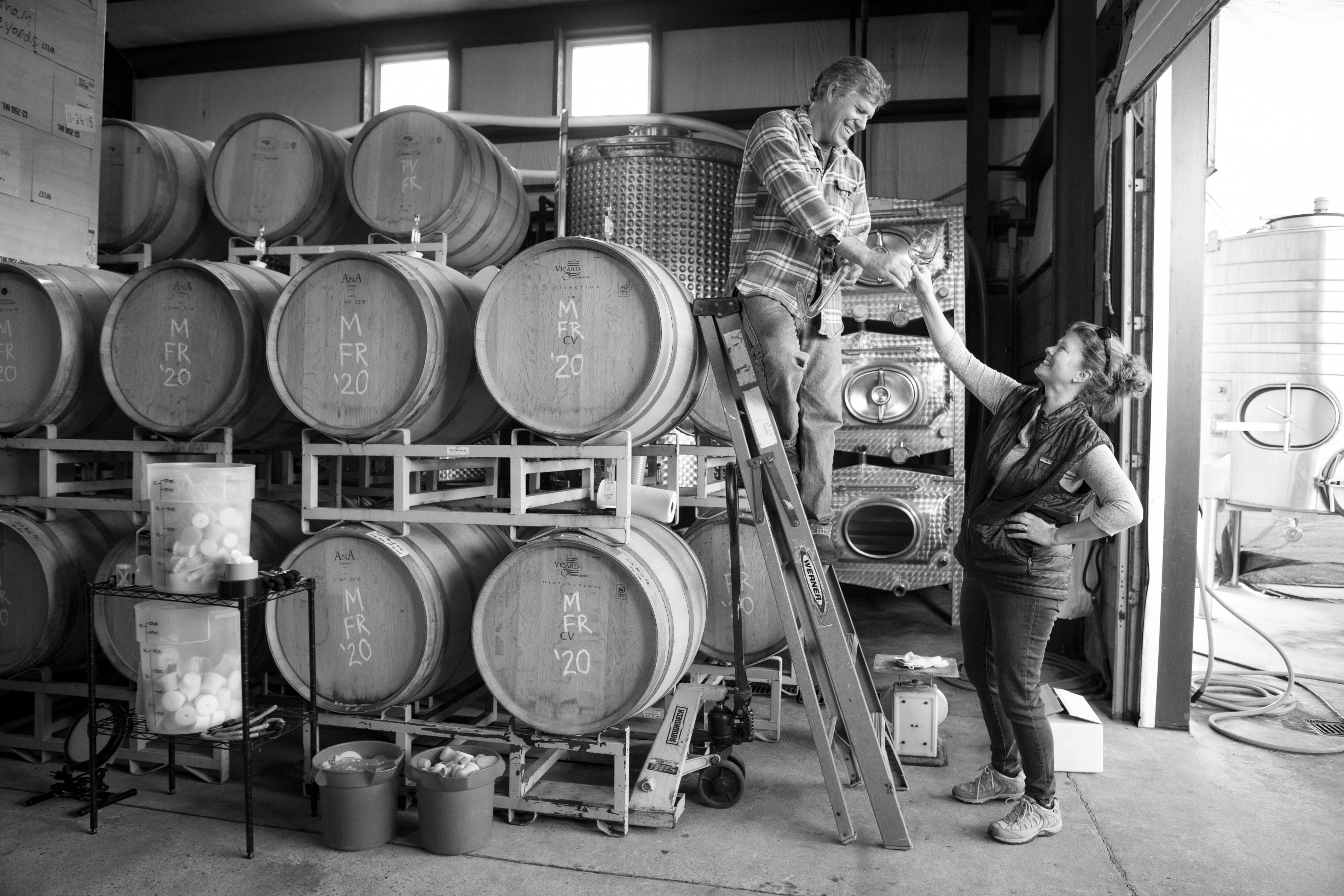Blog
Blog
A 25th anniversary and champagne pair well together, though at Chatham Vineyards, commemorating that milestone with a glass of Steel Chardonnay feels more fitting!
The only winery on Virginia’s Eastern Shore marks its 25th year in business this year. Cheers to Jon and Mills Wehner, who embrace every aspect of their grape growing business and boutique winery, including a genuine commitment to time. Jon likes to say, “The fast way is the slow way,” and he credits the invaluable lessons he’s learned over the last 25 years to that patience.
He shares a few of those nuggets here.

Our roots
Chatham’s relationship with Lucie Morton, a viticulture rock star, dates back to 1975 when Lucie first met Jon’s parents, Harrison and Joan, who operated their own small vineyard in Great Falls, Virginia. The internationally recognized author, ampelographer and consultant was the first person Jon turned to when he decided to start a vineyard on Virginia’s Eastern Shore. While the recommendations Lucie offered were unorthodox at the time, they laid the vital foundation for longevity. In the vineyard, Lucie suggested high density, European vertical shoot positioning planting or tractor rows of 7 feet and vine spacing of no more than 4 feet.
In Virginia, those ideas were radical ideas. Most embraced the standard thinking that in order to reduce vegetative vigor, big trellis systems were necessary. In Lucie’s estimation, planting a closer spaced vineyard with strict vertical shoot positioning maximizes vines per acre — better for the mechanization that she saw coming in the future. Positioning grapes to reap the benefits of the best sunlight and wind produces a high quality. Jon invested in the long game and trusted Lucie, following every one of her suggestions, including cane pruning in order to make the vines less susceptible to disease and planting the first-generation Dijon clones that continue to thrive.
It’s no surprise that Lucie, who holds the distinction of having a rootstock named for her, saw what few others could.
Peak Performance
Chatham’s Chardonnay vineyard that dates back to 1999 and its Dijon clone vineyard, planted a year later, both offer wonderful quality after 25 years. Wines produced from these vineyards are unmistakable. “Think how unique it is to taste the Steel Chardonnay from vineyards that are 25 years old,” Jon says.
While Jon initially leaned toward planting Sauvignon Blanc, he went with the Chardonnay per Lucie’s suggestion, which does well in diverse climates and coastal areas.
The Chardonnay didn’t disappoint. Jon compares grape vines to people in that they all peak at different ages. These older vineyards continue to be healthy and produce great yields. With good stewardship, they are primed to thrive for the next 25 years.
Fruits of Labor
Chatham’s Dijon Chardonnay clone vineyards, first generation French clones, are low producing and cost triple to farm compared to Chatham’s California clones, for example. But the taste of berries and the aromatics from the fermentation in the steel tank combine for something special. “The undeniable distinct aromatics of an old generation French Dijon vineyard can’t be replicated,” Jon says. “It’s all worth it when you taste it in the cellar.” And, ultimately, in the bottle.
Listen to Your Mother!
Chatham’s Steel Chardonnay, which has no oak, ferments in stainless steel unlike its Oak Chardonnay, which ages in oak barrels. These are two distinct wines, which wasn’t the original intention.
It was Jon’s mother, Joan, who sampled both in 2004 and offered a unique thought: “These are two completely different wines. Why don’t you just keep them separate?”
Today the Steel Chard is Chatham’s signature wine. Its more complex Oak Chard is a well-balanced food wine with a devoted following, too.
It’s never surprising when Mom knows best.
Location, Location, Location
Vines adapt and take on place, terroir. Chatham Vineyards’ site-expressive wines reflect the minerality of an ancient seabed and salt air and salt deposits in soil. Add in years of growing, prudent viticulture and time. The roots mine to a much deeper level — through the top soil, the band of clay, the silt and loam, deep into ancient shell and end up in iron ore or the beginning stages of gravel.
The rootstocks feed on the calcified marine deposits that come from layers of ancient shell in the soil and benefit from the favorable microclimate due, in part, to their proximity to the tidal waters of the Chesapeake Bay and Atlantic Ocean.
As the surface roots have been abandoned through mechanical cultivation, they are forced to mine the soil, and this only happens over time. Chatham’s wines are beginning to reflect the age of the vineyard.
First Class Flight
When Chatham opened its doors, none of its wines were more than two years old.
Today visitors to the tasting room can enjoy a full flight of six wines: 2022 Steel Chardonnay, 2022 Rosé, 2021 Oak Chardonnay, 2019 Merlot, 2020 Vintner’s Blend and 2021 Cabernet Franc. (For a half flight, choose your three favorites!)
“It wonderful to finally be able to have the depth of vintages to offer our customers wines from four different years,” Jon says. “As we make more wine and wines age longer, we have the luxury of offering various vintages.”
Be Yourself
Twenty-five years ago, Jon wanted to be like other wine regions and Chatham’s wine earned acclaim in competition. His thinking has changed dramatically. Chatham is distinctly Chatham — 21 acres of vineyards on land that overlooks Church Creek on a working family farm that has been operational for four centuries. It’s not Napa and it’s distinct from any other wine region in Virginia. Being a major player in the big leagues is no longer important to Jon. Nobody does Chatham like Chatham because there’s only one Chatham Vineyards.
Cheers to its 25th anniversary!

